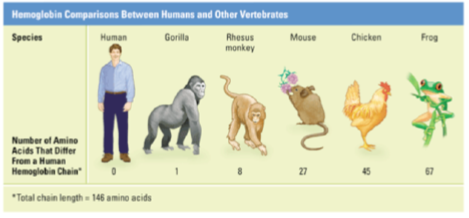5.9 Many Genes are Highly Conserved
DNA expresses itself with astounding fidelity. For example, the protein cytochrome c (cyt c) and its corresponding gene are highly conserved, meaning that cyt c has changed little over evolutionary time. At ~100 amino acids long, cyt c is involved in aerobic respiration and is therefore part of every organism that depends on oxygen. Pigs, cows and sheep have identical cyt c molecules—amino acid for amino acid. Similarly, the cytochrome c of chickens and turkeys is identical, and ducks only differ from chickens and turkeys by one amino acid. In fact, researchers have inserted cyt c genes from fish, horses, humans and birds into the genomes of single- celled yeasts, and the yeasts have successfully produced cyt c protein.
Similarly, hemoglobin, the protein that conducts oxygen in our red blood cells, has changed little throughout evolution. Hemoglobin is also essential to most organisms that depend on oxygen, so presumably most changes (or mutations) to the hemoglobin gene were selected against. These conserved genes and protein products also provide insight into evolutionary relationships…a type of molecular evidence for evolution.


